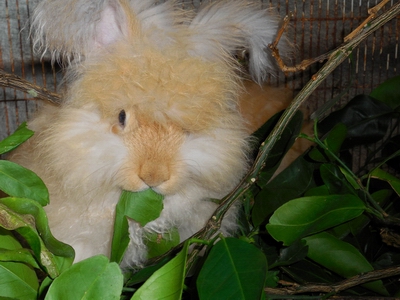Click on the bunny for the Home Page
Sewing Machines, Extra Fuzzy Boys and Volcanos
its been a busy week!
It's already been a bit of a busy week and it's only Thursday! Not sure if Sunday is the beginning of the week or the end of the week, but last Sunday a sewing machine was found at the dump.
I'm not sure how it works in your town, but here folks take their rubbish up to a rubbish tip where it is gathered in one spot to be collected by the County folks. Sometimes when folks have something that they don't want anymore but isn't really rubbish, it will be set sorta off to the side where it will hopefully get carried off and not clutter up the landfill.
There was an old industrial sewing machine sitting there so I had to look at it. Unfortunately, it had some rust issues as well as missing parts issues, so we left that one there. However sitting next to it was a sewing machine in a carrying case. I cracked the case open enough to see that there was a machine inside and it was a brown one about the same color as the Singer 401A sewing machine that was refurbished about a year ago. So I figured it was hopefully at least good for parts and dragged it off. Well, carried it really, although those old machines are heavy!
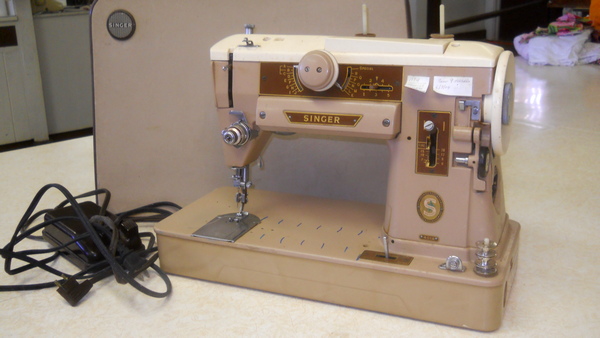
as found Singer 401A 'Slant-O-Matic'
This is what it looked like when I set it up at Crafty Group this week. Crafty Group meets at the Hongwanji with lots of flat table space and we're there from 10 am until 5 pm. That means large flat areas for a long time so it seemed a good time to check the machine out and see if it was functional.
I'd not known which machine was inside, it did have a 'Singer' logo on the outside of the case. I'd figured something in the 400 series since I'd gotten a glimpse of a brown color but didn't expect a 401A since that's the more expensive version and I would have expected one of that model to be in a cabinet instead of a carrying case. However, I was very pleased to find it was a Singer 'Slant-O-Matic' 401A. Especially since that exactly matches the one here that was restored last year so at worst case scenario, if I couldn't get this just found one working again, I'd have parts for the other one.
Initially, it was very stiff and took some effort to move the needle up and down. One of the levers on the knob to choose stitches was frozen. The bobbin case wasn't set in correctly. None of those are all that difficult to repair, but perhaps all of them combined was enough that they didn't want the machine anymore.
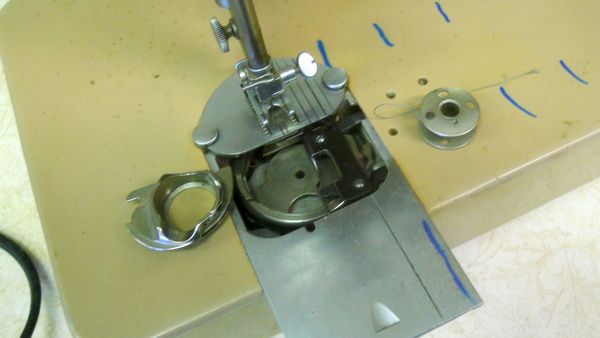
loose parts but at least they were there
The part that the bobbin fits in wasn't properly installed and the needle had bent, so I suppose that may have been one reason why they put it at the dump. For whatever reason, I'm glad all the parts were there! Although, with this model of sewing machine, parts are still available.
It's supposed to have been made in 1958 in Anderson, South Carolina. Which means this machine is around sixty years old. And found at a dump.

After a bit of elbow grease and machine oil
It took a couple hours of fussing at it, a bit of machine oil, a bit of grease and a bit of elbow grease as well as a bit of cleaning up, but "it's alive!"
I think a lot of the problem was the bobbin carrier not fitting in correctly. It took three tries to get it set in correctly, not sure why, that sort of thing is usually an easy thing to do. I did have it working after the second attempt to install the case carrier, but it was making a lot of racket. These machines are supposed to purr, not rattle. So, the bobbin case was taken out and finally fitted in correctly. Now she purrs with no noisy chatter. Woot!
For those of you who don't track the particulars of vintage sewing machines, the Singer 401A 'Slant-O-Matic' is an all metal direct drive machine. Most sewing machines have a drive belt which can slip, slacken or break. This is direct gear drive. It may weigh a ton, (I should actually weigh this thing) but it's rock solid and sews a much nicer seam than many new machines. It can also sew with two needles mounted side by side. Most machines require a special double needle in order to do two needle sewing.
These old vintage machines are quite versatile. The first thing I tried was the terry cloth rag I'd been cleaning the machine with. Doubled over, no problem, it sewed it evenly with nice tight straight stitches. Then it didn't take much to get it to sew a paper towel. I didn't change the needlr or thread, but the foot tension was adjusted for the different 'fabrics'. Absolute even tension, even when sewing a paper towel.
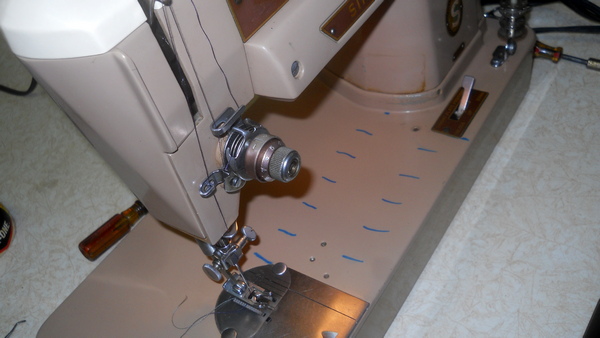
wretched Sharpies!
After last Tuesdays work session, the only thing left to do is to figure out how to get the Sharpie marker marks off the bed of the machine. Not sure what they were doing, but it needed very untidy marks about an inch and a half apart. Most folks would have used masking tape instead of a Sharpie marker, but perhaps the machine was disrespected and unloved for awhile before it found itself at the dump.
Now it can start a new life as a traveling sewing machine and go to Crafty Group as well as Quilting Group. These old machines sew really well, the only drawback is they weigh a ton, but they are durable. And very fixable, too. Try that with one of the modern electronic machines. The old vintage machines make lovely seams and this one has not only the zig zag stitch but a lot of other built in stitches as well. I've also already gotten all the slant shank accessories for the other Singer 401A. Nice to not have to go find new accessories.
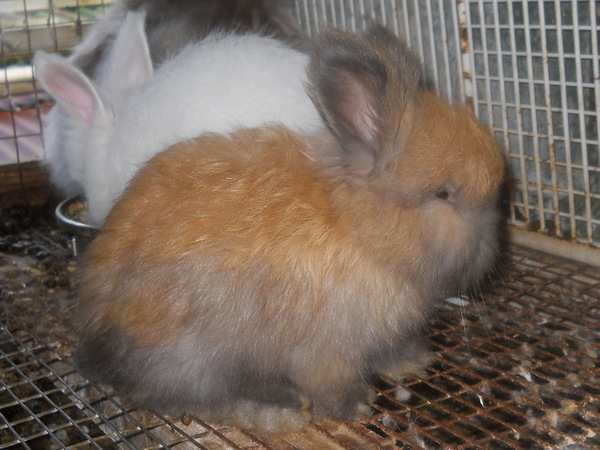
5 week old tortoiseshell buck
I was just looking at the babies today and noticed the boy bunnies seemed fuzzier than the girl bunnies. What's up with that? Of course, with the data determined from a sample size of four, it may not be very accurate data. But, both boys had distinctly fuzzier ears than the girls. The picture above is a five week old tortoiseshell buck. See how fuzzy his ears are? He seems to have a much denser coat, too. I think this one will get a flower name and stay here. What's a good flower name for a tortoiseshell boy bunny?
The pink ears on the white bunny in the back ground belong to Daisy. She is a Ruby Eyed White and a doe. She's a littermate to both of the extra-fuzzy eared boys.
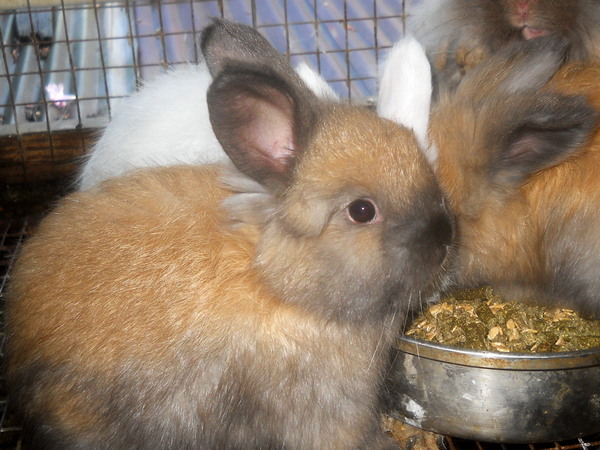
5 week old tortoiseshell doe
This is the Extra-Fuzzy Eared boys other sister. She has a very nice 'doe' type face, but notice how her ears don't seem to be as fuzzy as her brothers. Those are his ears on the other side of the food dish. It will be interesting to see if she gets as fuzzy as he already is in a week or two. Or perhaps there will be a texture difference between them? I don't know if she's going to have as much 'furnishings' (fuzziness) on her ears as an adult as her brother. It will be something to watch as they get older.

5 week old tortoiseshell doe, her REW sister and black brother
The babies are now old enough to hang out on top of the nestbox. Jessie has pretty much weaned them and they're pretty much eating solid foods. Now they've taken over mum's hiding spot on top of the nest box.
That is the little tortoiseshell doe in front. You can tell it's her because her ears aren't as fuzzy as her tortoiseshell brother's ears. Behind her is her Ruby Eyed White sister. Who also doesn't have ears as fuzzy as their brothers. In the back, with the fuzzy ears, is their black brother.
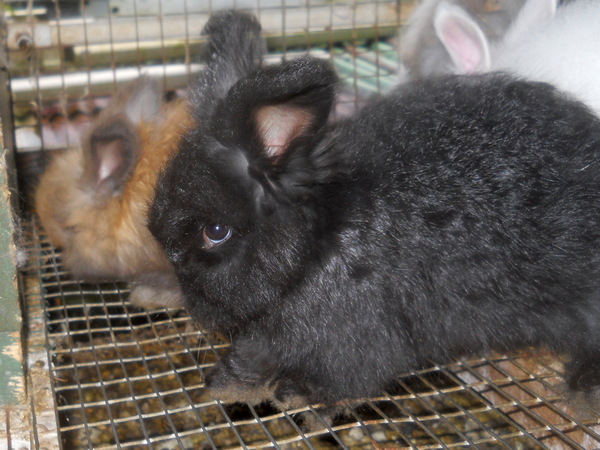
5 week old black buck
Here's another picture of the fuzzy ears on the boy bunny. He's a nice little buck. I've not compared the two bucks together, but one if not both of them will be staying here. It's important to keep the best bucks for future litters.
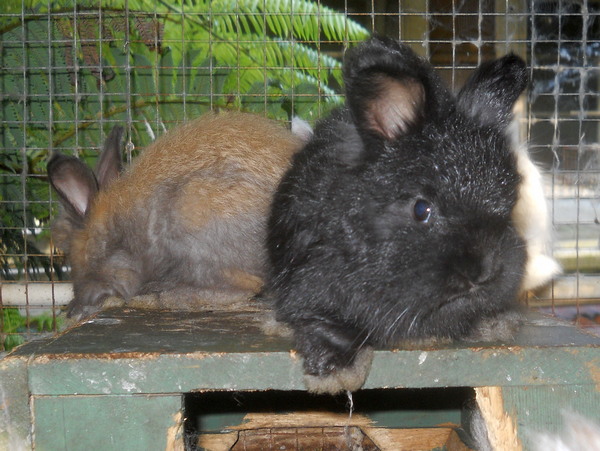
Baby black buck
More pictures of the little black buck, just 'cuz he's cute.

Spot at 11 weeks
This is Spot. She's from Jessie & Nero's litter earlier this year. She's now eleven weeks old. She was going to go to Molokai, but we haven't been able to find a plane that will take bunnies from here to there. Oahu, Maui and Kauai, no problem. Molokai, problem! Hmpf! They'll take cats and dogs but not bunnies. So, Spot and her sister Speck are still here.
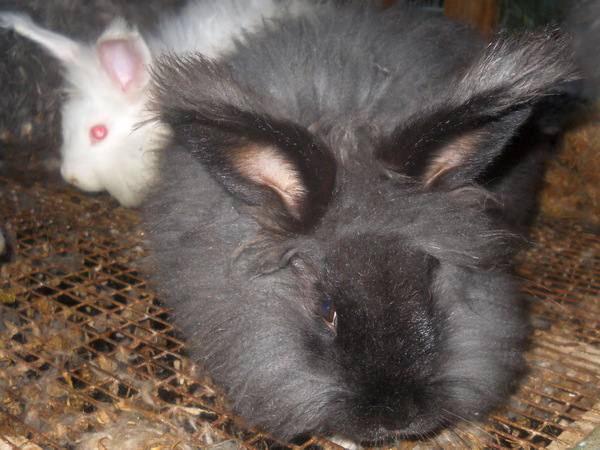
Speck at 11 weeks old
Speck is still here, too, since she was going to go to Molokai with her sister Spot. Guess they will find new homes sometime soon, although I've not officially listed them as available yet. Guess I need to get caught up on internet things.

Sister Petunia at 11 weeks old
This is Spot and Speck's sister, Petunia, at 11 weeks old. She illustrates how the hybrid bunnies don't seem to have as much fuzziness on their faces and ears as the purebred English angoras do. In another month or so, I'll harvest her coat and compare her fiber to that from a pure English angora and see how they compare. Petunia, Spot and Speck are all 3/4ths English, 1/8th Satin and 1/8th German angora.
English angoras have a different body shape than Satins and Germans. English are like half of an extremely fuzzy soccer ball. The Satins and Germans are more like a ferociously fuzzy loaf of bread. They also have differences in their wool quality and texture. I don't think we will be breeding any more hybrids. If we want the different textures in our Hula Bunny yarn, I think we will just raise some Satins and Germans.
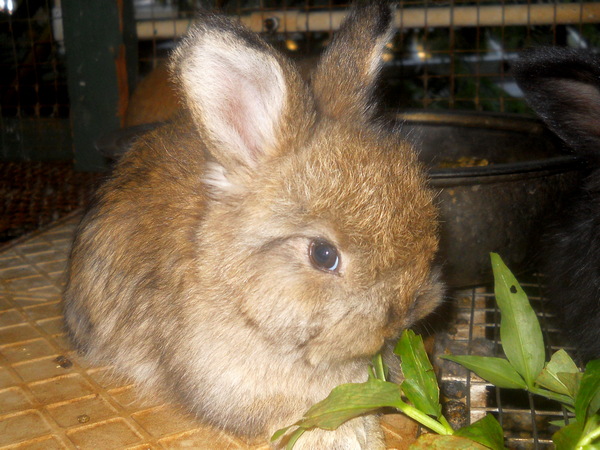
4 week old tortoiseshell buck
This is the little agouti buck from Cassandra and Augustus' litter. He's a buck, at least, I think so. It can be a bit hard to definitely tell gender at this age. Anyway, I think he's a buck and he seems to have pretty fuzzy ears. He's a hybrid, though, so is he going to have the full amount of fuzz?
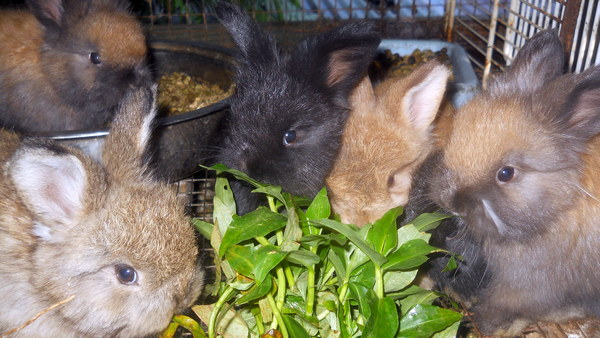
Snack time for the 4 week olds
These are the four week olds from Cassie and Augustus. Six of them are males so if we're going with the 'males have fuzzier ears theory' I should figure out which two are the females and compare ears. One of the black ones and one of the tortoiseshell ones are females. Although which black and which tort in the picture, I dunno.
This is the first time I've been to Volcano National Park since the volcano had that huge lava flow that started early last May. It has stopped now, but before it was over we lost hundreds of houses and some lovely shoreline over in the Puna district.
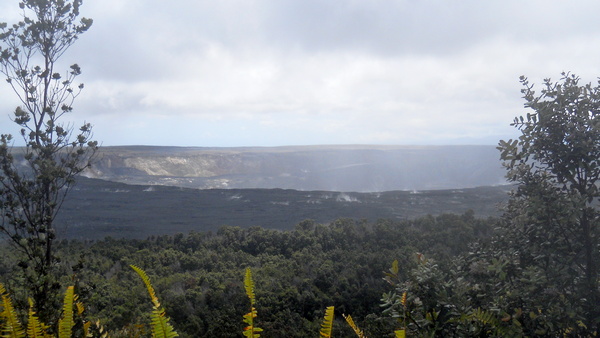
Halemaumau crater
This is overlooking Halemaumau crater from the back of Volcano House. This view used to be a large flat plain of cooled off lava with a caldera off to one far side of it. I don't know how much bigger it's gotten, but it's absolutely huge now!
The lake of lava is no longer inside the caldera. The view from here used to be this big flat cooled lava plain, over on the side was a big (but not ginormous like it is now) caldera. Inside the caldera was another flat lava lake, except the lava in the caldera was still live and would move higher and lower and occasionally have red hot/orange lave burbling up in it. Lots more emissions or vog (volcanic smog). But, that was then, this is now.

Overlooking Halemaumau crater
We're actually quite aways away from the now empty and enlarged caldera. Maybe it's now a crater instead of a caldera? If there's no more lava in it, is it still a caldera? Anyway, thats an ohia forest down on the level of the lava plain, so those are trees which may help show the scale of the picture.
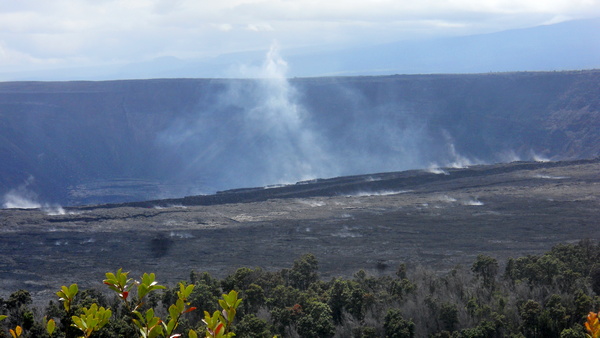
Craters Edge
This is kind of a far away shot and I don't have that good of a camera, but it looks to me like that edge of the crater is really unstable. The Jaegger Museum which is up on the crater rim is no longer in use since the edge it's on is supposed to be unstable, too.
It's probably humbug for the tourists who want to see live lava, but it's kinda nice that the volcano is taking a break for awhile. We used to get these volcanic emissions known as 'vog' and they would make my eyes and nose sore. It also was like smog everywhere and things just weren't as beautiful. Also hard on the crops. So now that the volcano has stopped spewing lava and vog, the air is crystal clear, things are gorgeous and I'm sure land prices in Kona are gonna triple.
A friend did observe to me yesterday that there will likely be more rain in Kailua-Kona. Apparently, the heat from the volcano would affect the rain patterns which made the Ka'u desert (the area directly downwind from the volcano) much drier and those effects would wrap around to the Kona side. Something else to watch, I guess. Not as much fun as baby bunnies, tho.
